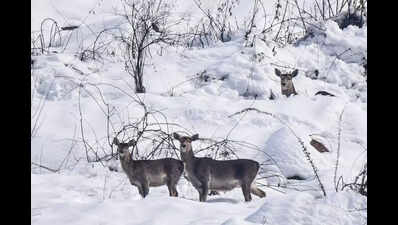Hyderabad: A study by scientists from the Laboratory for the Conservation of Endangered Species (LaCONES) at CSIR-Centre for Cellular & Molecular Biology (CCMB), Hyderabad, has provided vital insights into the reproductive cycles and stress patterns of the critically endangered Kashmir stag, also known as hangul. Led by Govindhaswamy Umapathy, the research, published in Scientific Reports of Nature, focuses on understanding the species’ reproductive seasons to aid conservation efforts.
Using non-invasive faecal hormone analysis, the study tracked variations in reproductive stages and stress levels in both male and female hangul. The findings suggest that human disturbances, especially from migratory livestock herders, contribute to stress during critical reproductive phases, indicating the need for protective measures during these times.
The Kashmir hangul, a species of red deer found in Central Asia, is primarily confined to Dachigam National Park, where the last recorded population in 2017 was just 182 individuals. Like other red deer, hangul follows a seasonal breeding pattern with males competing for females during the rutting season.
Hangul stress patterns
Over the course of a year, researchers monitored 11 permanent trails in lower Dachigam and collected 1,172 faecal samples. The study found that male hangul experience a synchronised rutting season from October to December, while females have a more spread-out mating and birthing pattern. Elevated progesterone levels in females between January and March suggested pregnancies, while a drop in April indicated parturition.
The study also revealed significant stress spikes in both males and females during the mating season, reflected in rising glucocorticoid metabolites. An additional stress peak in April and May for females coincided with parturition, and movements of migratory livestock herders in May could be contributing to this stress.
Future research
This study marks the first detailed hormonal profiling of hangul in the wild, providing a baseline for future conservation strategies, including captive breeding programs. The findings indicate that the reproductive seasonality of hangul differs from other red deer species, likely due to habitat and food availability differences.
Researchers emphasise minimising human disturbances during mating and birthing periods to enhance hangul survival. They also call for further studies, including camera trapping surveys, to confirm the timing of these events. Given the species’ endangered status, long-term monitoring and adaptive conservation strategies are essential to ensure its survival, researchers say.









